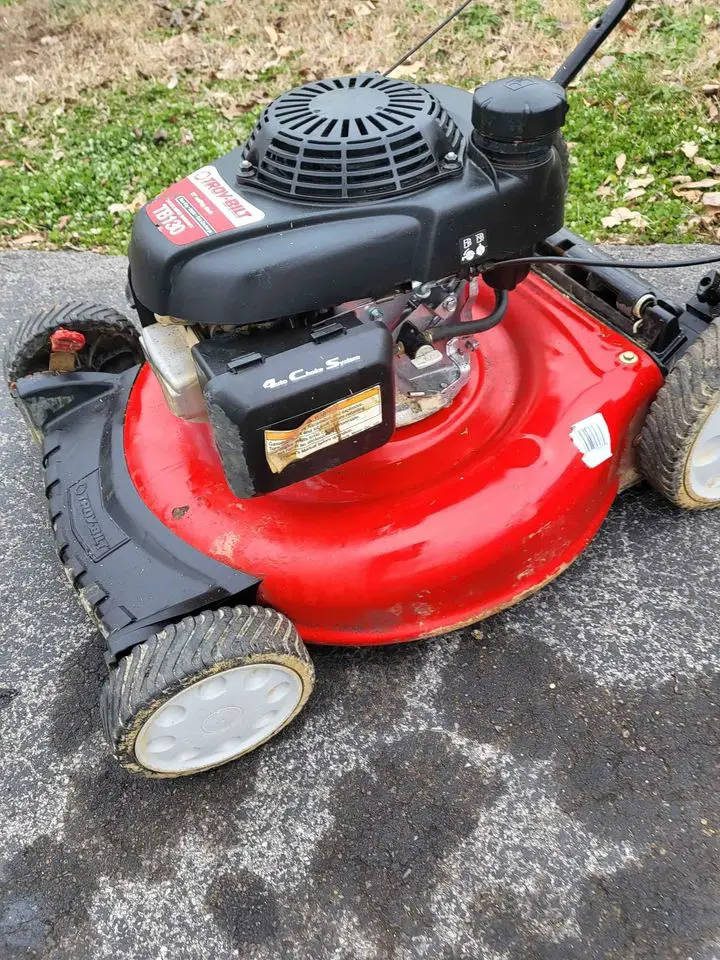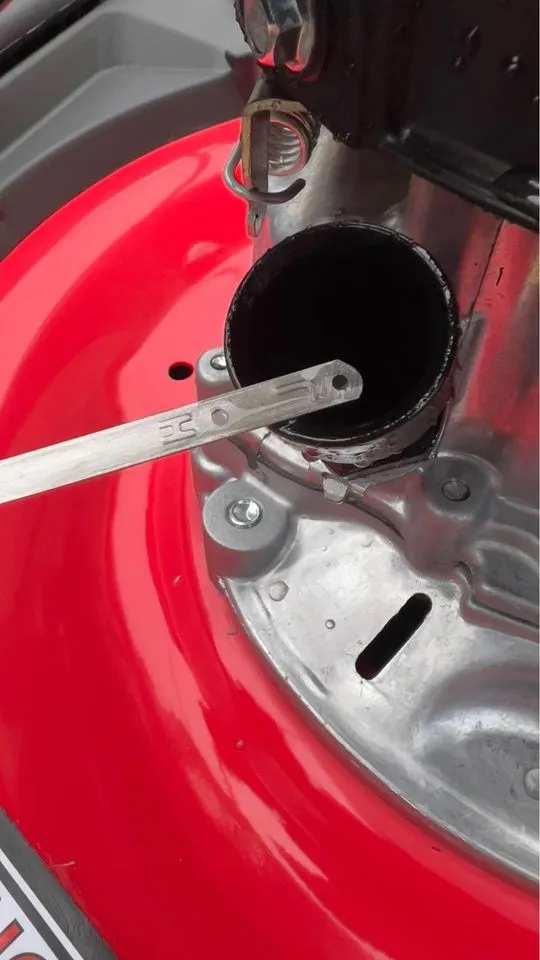Welcome to our comprehensive guide on selecting the right oil for your push mower. As an experienced maintenance expert with years of hands-on experience in lawn care equipment, I’m here to provide you with clear, concise, and valuable insights.
I’m here to help you understand the importance of choosing the appropriate oil for your push mower, ensuring optimal performance and longevity.
Trust in my expertise as we delve into the specifics of mower oil selection, tailored to enhance your mower’s efficiency and safeguard its operation.
Quick Summary
- For optimal maintenance of push mowers, it’s crucial to choose the right oil type, such as SAE 30 or 10W-30 for four-stroke engines and a proper gas-oil mix for two-stroke engines.
- Selecting the correct oil involves considering the mower’s engine type (four-cycle vs. two-cycle), the oil’s viscosity rating, and environmental factors.
- Over 60% of lawn mower owners neglect recommended oil change schedules, potentially shortening the lifespan of their mowers.
- I believe investing in high-quality motor oil for my mower is as important as choosing the best fuel for my car, ensuring top-notch performance and longevity.
What Type of Oil for a Lawn Mower?
For my push mower, I always check the owner’s manual first. It provides the most accurate information on what oil to use. It’s also important to consider whether my mower has a four-stroke or a two-stroke engine.
Four-stroke engines require separate oil and gasoline, whereas two-stroke engines need a specific mix of oil and gas to function properly.
I also pay attention to the “service” rating of the oil, which tells me about the oil’s performance level. The American Petroleum Institute (API) provides these ratings, and I look for oils with a ‘service’ rating of SG, SF, SH, SJ, or higher.
These ensure that the oil meets current engine protection standards and fuel efficiency requirements.
- SG: Introduced in the late 1980s, this rating was for oils designed for 1989 through 1993 vehicles.
- SF: This was used for oils suitable for cars built in the 1980s.
- SH: Appeared in 1992 and represented an improvement over SG rated oils.
- SJ: Introduced in 1996, this rating marked another step up in performance, particularly in terms of compatibility with certain critical engine components.
Related: What Kind of Oil to Use in a Husqvarna Zero Turn Mower
Other Types of Oil for Lawn Mowers
While SAE 30 and SAE 10W-30 are common choices for lawn mower oil, there are other options to consider based on your mower’s engine type and the conditions in which you’ll be using it.
If you’re running a mower with a two-cycle engine, you’ll need oil specifically designed for that type, often labeled as 2-cycle or 2-stroke oil. This oil gets mixed with gasoline to provide both fuel and lubrication to the engine.
For those living in colder climates, where temperatures can dip quite low, a synthetic SAE 5W-30 can offer better cold-weather starting and improved engine protection.
Synthetics flow more easily at low temperatures, ensuring that your mower’s engine isn’t starved of lubrication when you start it up on a chilly morning.
On the other hand, if you’ve got a diesel-powered mower, you’ll need to look for engine oil that meets the specifications for diesel engines.
Usually, these oils have a higher viscosity and are formulated to handle the unique demands of diesel engines, such as increased soot and combustion byproducts.
Always remember to check your mower’s manual for the manufacturer’s oil recommendations. That’s the best way to ensure you’re giving your mower exactly what it needs for a long and productive life.
Four-cycle Engines vs. Two-cycle Engines

Understanding the differences between four-cycle and two-cycle engines is crucial when selecting the right oil for your push mower.
Typically, four-cycle engines, also known as four-stroke engines, have a separate compartment for oil and don’t require you to mix oil with the fuel. They’re more common in push mowers and are known for their efficiency and durability.
I make sure to use a high-quality detergent oil that’s rated at least SJ; it’s what most four-cycle engines will require.
On the other hand, two-cycle engines, or two-stroke engines, need a specific oil and fuel mixture to operate.
It’s vital that I don’t use standard motor oil for these types of engines because it can cause damage and won’t properly lubricate the internal components.
Instead, I always use a two-stroke engine oil, which is specially formulated to mix with gasoline and burn cleanly to prevent residue buildup.
The mix ratio is also important to note. For most two-cycle engines, a 50:1 ratio of fuel to oil is standard, but it’s always best to check the user manual for the exact specifications.
If I’m unsure, I consult the manufacturer’s guidelines to prevent any mishaps. It’s all about keeping that balance to ensure a long life for my mower’s engine.
Synthetic vs. Conventional Oil for Push Mowers

When it comes to maintaining your push mower, the choice between synthetic and conventional oil is crucial for both performance and longevity.
Understanding how these oils perform in different climatic conditions can guide users in making an informed decision that balances cost, protection, and maintenance frequency.
Synthetic oils are engineered for superior performance, especially in extreme temperatures. Their ability to resist thickening in cold weather and thinning in high heat makes them ideal for areas with significant weather fluctuations.
This stability means less frequent oil changes, saving time and hassle. Synthetic oils also offer enhanced protection against engine wear and tear, which is beneficial for heavy-use scenarios or irregular maintenance schedules.
Conventional oils, in contrast, are generally more cost-effective and suitable for moderate climates. While they may not provide the same level of protection in extreme conditions, they are adequate for typical backyard mowing.
Conventional oils might necessitate more regular maintenance schedules, but for users sticking to these, they offer a balance of performance and affordability.
Ultimately, the choice depends on the local climate, the intensity of mower use, and the user’s preference for maintenance frequency and cost.
For those in areas with extreme weather, or who prefer extended intervals between oil changes and maximum engine protection, synthetic oil is the recommended choice.
Conversely, for moderate climates and regular maintenance, conventional oil can suffice.
How Often Should I Be Changing the Lawn Mower’s Oil?
I should change the oil in my push mower at least once per mowing season or after every 50 hours of use, whichever comes first, to ensure optimal performance.
This routine isn’t just a suggestion—it’s essential for keeping the engine running smoothly and extending the life of my mower.
Fresh oil lubricates the engine’s moving parts, cools the engine by transferring heat away, and keeps internal components clean by minimizing build-up.
Sticking to this schedule can seem like a hassle, but it’s worth the effort. If I neglect to change the oil, I’d likely face a sluggish mower or, worse, an engine failure. I’ve learned that the type of oil and the mowing conditions can influence the frequency.
For instance, if I’m cutting very tall or wet grass, I might need to change the oil more often due to the extra strain on the engine.
For the most accurate guidance, I consult my mower’s manual. It provides specific recommendations tailored to my model.
By keeping on top of my mower’s maintenance, I know I’m safeguarding its performance and ensuring it’s ready to handle the job season after season.
Specifics of Oil Change Procedures
Changing the oil in a push mower is a vital maintenance task, yet the specifics of this process are often overlooked in general advice. An oil change starts by running the engine for a few minutes to warm up the oil, making it easier to drain.
Then, the mower should be carefully tilted to drain the oil from the fill port, avoiding environmental contamination. A key point is to emphasize the importance of using an oil-safe drain pan and proper disposal of the used oil.
Additionally, the procedure might differ slightly based on the mower’s design, such as the presence or absence of a drain plug.
Understanding Viscosity Ratings in Depth

The viscosity rating of oil, like SAE 30 or 10W-30, is critical for optimal mower performance, but what do these numbers mean?
The first part of a multi-grade oil rating (e.g., the “10W” in 10W-30) indicates the oil’s viscosity at cold temperatures (the ‘W’ stands for winter).
The lower this number, the thinner the oil at cold temperatures, which is crucial for starting the engine in colder weather.
The second number (e.g., the “30” in 10W-30) represents the oil’s viscosity at high temperatures.
Understanding these ratings helps in selecting an oil that provides sufficient lubrication across different temperature ranges.
The Role of Engine Design in Oil Selection
The design of the mower’s engine plays a significant role in the type of oil it requires. For instance, overhead valve engines may need different oil types compared to traditional flathead engines due to their distinct lubrication requirements.
Overhead valve designs, being more modern, might benefit more from multi-grade or synthetic oils, which offer better protection for the intricate valve mechanisms.
Environmental Considerations in Oil Choice
The environmental impact of different lawn mower oils is a crucial consideration, especially for eco-conscious consumers.
Biodegradable or environmentally friendly oils are becoming more available and can significantly reduce the ecological footprint of lawn care activities. These oils break down more quickly and less harmfully in the environment compared to traditional oils.
Our Verdict
Having explored the intricacies of lawn mower maintenance, I’ve become even more committed to selecting the right oil for my trusty lawn mower.
For my four-stroke engine, I’ve found that nothing quite matches the efficiency and protection offered by SAE 30 or 10W-30 motor oil. It’s a bit like choosing the perfect tools for my gardening toolkit – absolutely essential and tailored to my needs.
If I were handling a two-stroke engine, preparing the gas-oil mixture would be a crucial part of my routine, much like mixing the perfect soil for my plants.
Whether opting for the reliability of conventional oil or the enhanced performance of synthetic, I’m dedicated to giving my mower the best.
Regularly changing the oil each season has become a key part of my lawn care ritual – a small step that ensures my mower is always ready for the task at hand.
Frequently Asked Questions
Can I use car engine oil in my push mower, or does it require a special type of oil?
I can typically use the same SAE 30 or 10W-30 oil as in cars for my mower, but I’ll check the manual to ensure it doesn’t need a specific type for optimal performance.
Are there any additives I should consider adding to my push mower’s oil to enhance performance or longevity?
I’m considering additives for my mower’s oil to boost performance and extend its life. However, I’ll need to ensure they’re suitable and won’t damage the engine. Research before adding anything is crucial.
How should I properly dispose of the old oil after changing it from my push mower?
I take my used mower oil to a recycling center or auto shop that accepts it. It’s important to not pour it down the drain or on the ground to protect the environment.
What are the environmental impacts of using different types of oil in push mowers, and how can I choose the most eco-friendly option?
Different oils affect the environment uniquely; I’ll research biodegradable options to lessen my impact. Choosing eco-friendly oil reduces pollution and protects ecosystems while maintaining my mower’s efficiency.
If my push mower has been sitting unused for an extended period, does the oil still need to be changed before use?
Yes, I’d still change the oil even if my push mower’s been idle for a while. Old oil can degrade, potentially causing harm to the engine when I start it up again.


